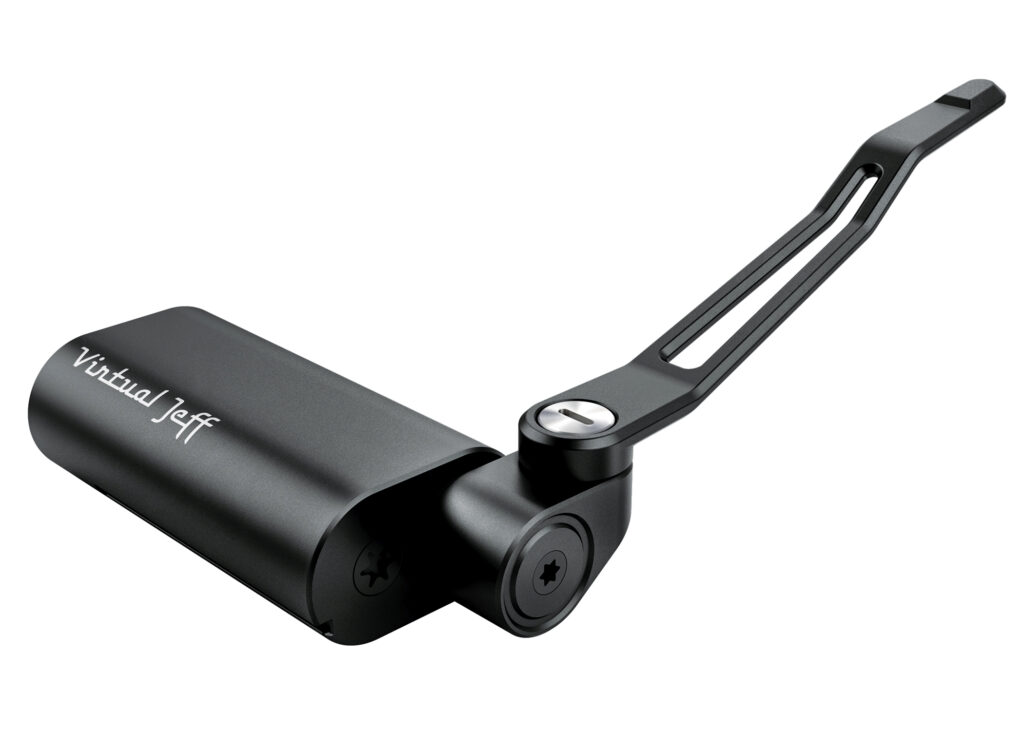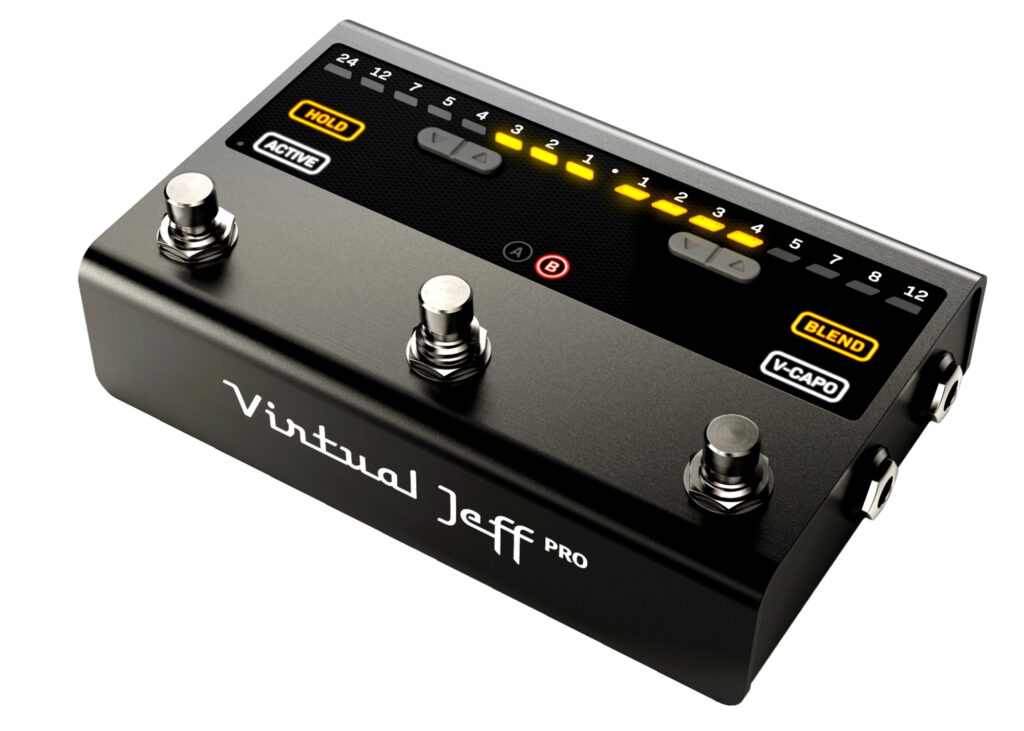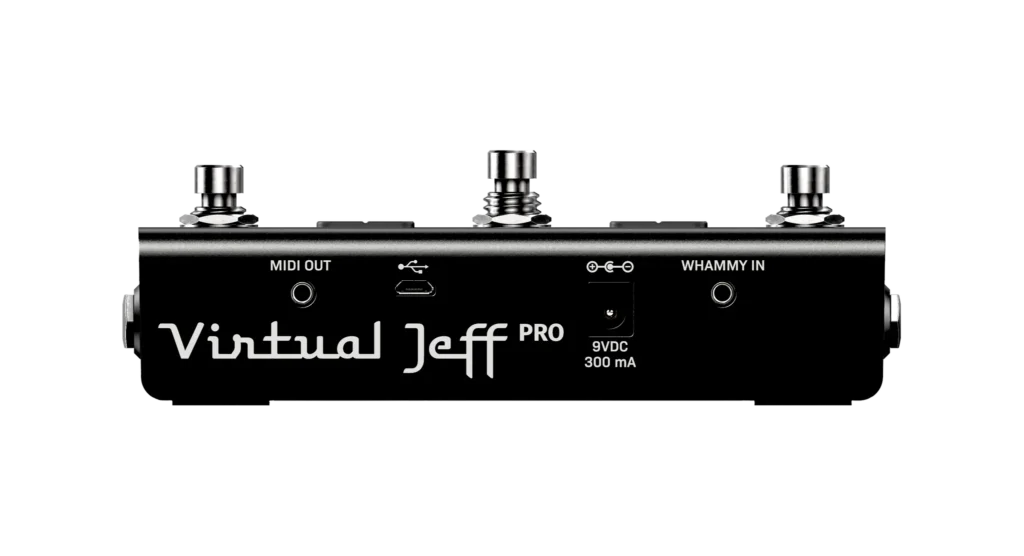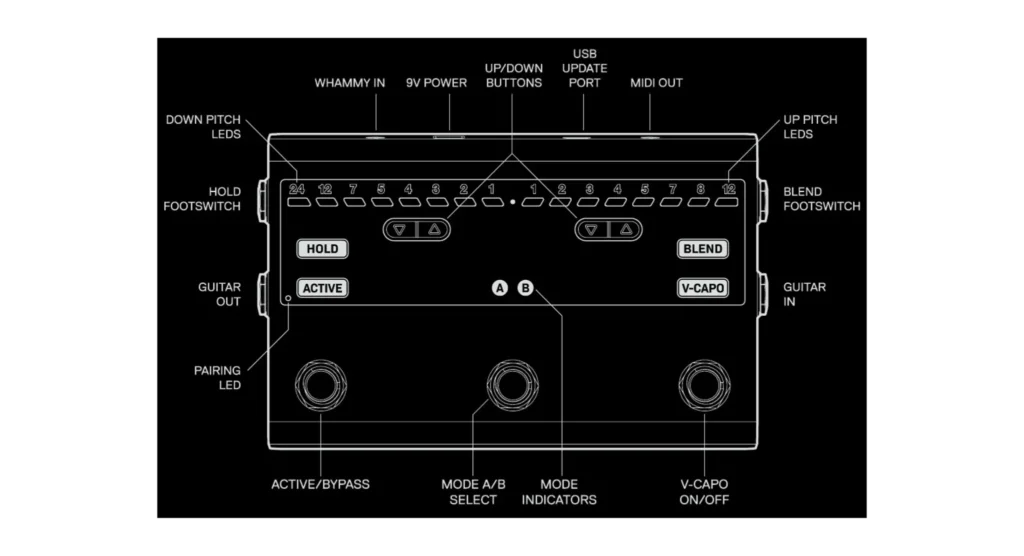This combo digital whammy/tremolo bar and pitch processor allows you to use whammy effects on virtually any guitar or other instrument–no wood-working required.
For years, I’ve rued the fact that my delightfully twangy, hard-tail (no tremolo) Telecaster couldn’t be used for whammy bar effects such as dives and glissando (slide up and down to notes). Quite by accident, I stumbled on the remedy in my travels around YouTube: FomoFX’s Virtual Jeff Pro digital whammy bar.
No snickers please. It’s a reference to the famous guitarist Jeff Beck and his well-known use of the whammy, aka, tremolo bar. Get your mind out of the gutter. 😉
What’s a whammy bar?
For the uninitiated, a whammy/tremolo bar is the handle to a guitar bridge that floats on pivots and can be rocked forward/down to lower the pitch of strings by diminishing tension, and backwards/up to raise the pitch by increasing tension. The bar and the bridge are called a tremolo system, such as those from Floyd Rose, Fender System One, etc.
How exactly can a whammy bar be digital? By foregoing actual manipulation of the strings and interfacing with a pitch-shifting digital stomp box that sits between your guitar and its amplification. Yup. You’re varying the pitch of the signal emanating from the guitar’s electronics, not the strings themselves.
Design and features
The Virtual Jeff Pro bar itself (shown below) is a horizontally rotatable lever (so you can push it out of the way) sitting on a vertically rotating potentiometer type deal. The latter’s movements are deciphered and relayed by a mechanism inside the housing it’s attached to. The unit comes with a separate semi-adhesive, pressure locking mount that allows you to remove the whammy module for use on other guitars.

There’s a second mount in the package that you can use for either the similarly-sized and styled wireless transmitter, or on a second guitar. The transmitter can be also be attached to your guitar strap via an included adapter.
The Virtual Jeff Pro magic comes courtesy of the aforementioned pitch processing stomp box, an approximately 6-inch long, 4-inch deep, 2-inch high (including the switches on top) sturdy metal unit that you plug your guitar into. It forwards the pitch-altered (or not) signal on to your amp or other audio destination.
The processor is capable of altering the pitch up to one octave higher and two octaves lower. You can also dial it in to as small a jump as a single major second either way, or none if you prefer. The range is set using buttons just below the LED readouts you can see in the picture below. There are two presets you can switch between using the middle foot switch. I used one to emulate my normal whammy travel and the other to experiment with.

Giant abilities and upside
If all the processor did was mimic a traditional whammy bar, that would’ve been fine in my book. However, it can also serve as a virtual capo, allowing you to easily play in other keys without re-tuning.
There’s also a feature called blend that lets you use an slightly altered pitch in mixed with the unprocessed l pitch to create a chorus effect. It’s nifty.
Another advantage to the electronic approach to pitch shifting is that you can mimic the whammy bar on any instrument that offers electric output. Including keyboards. A nice alternative, or adjunct to the pitch wheel.

Another benefit of the Virtual Jeff Pro is that it can also be used to add whammy post recording. If you know how to re-amp a guitar track, then you’re all set with this unit.
Also of benefit is that electronic shifting treats all the strings equally. A physical whammy bar, which is held in check by springs, tends to affect each string (which vary in thickness and tension) in a slightly different way.
If that weren’t enough, the Virtual Jeff won’t suck up any sustain that you lose with some physical whammy systems. You might even find yourself buying more hard tail guitars. Consider yourself warned.
Caveats
There are a couple of Virtual Jeff Pro, nature-of-the-beast characteristics that you should be aware of. First off, as it’s not acting on the strings, any sound emanating from said strings that reaches your ears will be in conflict pitch-wise with signal being altered by the pitch processor. This can be more than a tad disconcerting.
This is more likely to come into play when you’re using the Virtual Jeff Pro on an acoustic instrument. However, I often record listening through my DAW and monitors at low volumes rather than an amp, and I found I had to raise the volume a bit to avoid the conflict of pitches.
Headphones are another easy cure. In the end, it’s a small inconvenience considering the benefits of the Virtual Jeff Pro.
Also, the Virtual Jeff Pro requires a significantly lighter touch than a physical whammy/tremolo system. I definitely had to dial back my physical inputs. Again, no biggie.

Another consideration is that when you can change the lower and upper limits of the pitch shift on the box, you must adapt to how much arm travel is required for any given trick (sliding up a major second, diving a fifth, etc.).
Basically, you have to develop a different feel for each range setting. I suggest you find the settings that best suit your current repertoire before you go full on with the options. Given all that the Virtual Jeff Pro lets you do, a small price.
One more thing. As the Virtual Jeff Pro isn’t actually manipulating the strings, any noises or tricks that take advantage of the acoustic coupling of a physical tremolo system and the guitar/strings are a no-go. E.g. letting the bar/bridge snap back or rock violently to get the strings to react and vibrate without picking. Not something I do very often, but I did miss the catharsis of banging the snot out of my whammy once in a while.
Performance
I was amazed at how transparent the pitch processor is. I couldn’t spot any meaningful difference in tone with it engaged. The bar felt smooth, and it only took a few minutes to adjust to its feel. I’ve already described what it does, so I’ll just say that it does those things very, very well.
The pitch box also serves as a buffer (a box that restores signal sucked up by other boxes), which intentionally adds some high-end, even when the pitch tricks are bypassed. You can disable the buffer function by holding two buttons at power on and selecting a pure bypass mode with the buffer disabled. I left it on because I liked the effect.
All factors considered, I’d say it was only about 15 minutes before I was comfortable with the unit and making good use of it.
Final thoughts
I find the Virtual Jeff Pro a brilliant answer to long-standing conundrums–whammy effects with my hard-tail guitars and unstable tremolo systems. I can’t tell you how much time I’ve spent blocking, stopping, decking, and adjusting those cantankerous beasts.
That said, I’m not going to forsake physical tremolo systems. I’m used to them, they’re fun, and well… They’re already installed.
But the Virtual Jeff Pro has found its way into my heart. Mostly because I can use it on my older hard tails without losing the superior sustain they provide. It’s also opened my mind to purchasing new hard tails as I no longer consider them constrained.
Then there’s the virtual capo, huge pitch range, and other tricks that Virtual Jeff Pro performs that allow me to use my guitars where formerly I might’ve have switched to a keyboard. I’ve even used the Virtual Jeff Pro during re-amping/bouncing to help out some already recorded tracks.
The creative possibilities are vast and they’re hardly limited to the guitar. Highly recommended if you have the wherewithal.
Note that I got mine on sale for $369, but the price had risen to $499 as of time of this writing. Still, a fantastic device.